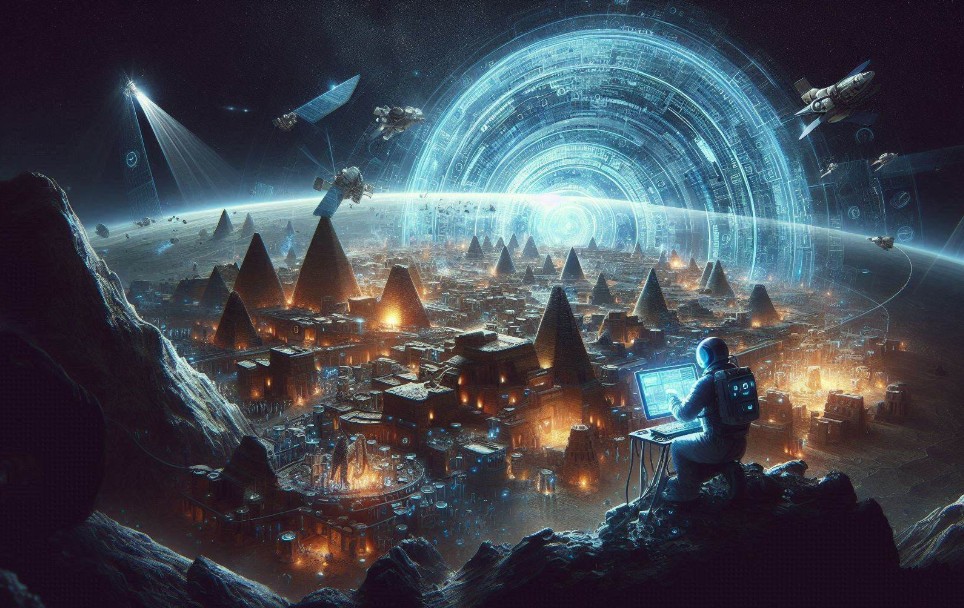In recent years, there has been a significant advancement in the field of Artificial Intelligence (AI) and Augmented Reality (AR). These technologies have become increasingly popular and have the potential to enhance virtual experiences in various fields such as gaming, education, healthcare, and...
Digital Archaeologist Discovers Ancient Settlements from Space

The exploration of forgotten civilizations has long fascinated historians and explorers alike. With modern advancements in technology, new tools have emerged that allow experts to examine our planet's surface in ways never before possible. These innovations open up exciting possibilities for uncovering long-lost traces of past human activity.
By using cutting-edge satellite imagery and sophisticated analysis techniques, researchers can now identify signs of old structures and pathways hidden beneath vegetation or soil. This method enables the detection of relics that would have been nearly impossible to find using traditional excavation methods.
As this field continues to evolve, it offers a glimpse into a future where the mysteries of the past may be unraveled from the sky, offering new insights into how ancient cultures lived, interacted, and shaped the world as we know it today.
How Satellite Technology Revolutionizes Archaeology
The use of satellite technology has transformed the way researchers study historical sites and uncover remnants of past civilizations. By capturing high-resolution images and analyzing data from above, experts can now observe large areas with unprecedented precision. This allows them to identify patterns and anomalies that might have gone unnoticed through traditional methods.
Advanced Imaging Techniques
Modern satellites employ a range of imaging techniques that provide detailed views of the Earth's surface. These methods enable the detection of previously hidden features, such as structures buried beneath vegetation or sand. Some key imaging technologies include:
- LiDAR (Light Detection and Ranging): This technique uses laser pulses to create 3D maps of the landscape, revealing hidden structures under dense foliage.
- Thermal Imaging: By measuring temperature variations, thermal imaging can help identify areas with man-made structures, as these often have different heat retention properties than natural surroundings.
- Radar Imaging: Radar systems penetrate through the earth and vegetation, allowing scientists to detect subterranean features without disturbing the soil.
Expanding Research Horizons
Satellite data has significantly expanded the scope of archaeological research. Researchers are no longer limited to digging in specific, previously known locations. With the ability to analyze vast landscapes, they can now pinpoint areas of interest that were previously inaccessible or unknown. This approach enhances the efficiency of archaeological fieldwork and speeds up the discovery of potential sites.
- Uncovering entire cities and networks that would take years to find through traditional excavation.
- Identifying historical routes and trade networks that were once hidden beneath modern developments.
The integration of satellite technology with traditional archaeological practices has opened up a new era of exploration, where ancient histories are revealed from a perspective never before possible.

Unveiling Lost Civilizations from Space
With the help of modern satellite technology, scientists have begun to uncover forgotten cultures and their legacies hidden beneath the earth's surface. By analyzing high-resolution imagery, researchers can identify remnants of historical sites that were once thought to be lost to time. This method allows experts to explore vast areas and locate traces of human habitation that were previously beyond reach.
Revealing Hidden Patterns
One of the most significant advantages of using satellites is the ability to spot geometric patterns and unusual formations that stand out in the landscape. These patterns often indicate the presence of large human-built structures, such as cities, roads, and waterways. The analysis of these features provides valuable insight into the scale and complexity of past societies.
- Geospatial Analysis: Combining satellite images with historical data helps researchers locate areas where ancient people might have lived or traded.
- Topographic Mapping: Elevation changes visible through satellite data can uncover the layout of structures buried under layers of earth or vegetation.
New Discoveries Beyond Excavation
Traditional excavation methods often require years of effort and can be limited by the availability of funds or the location's accessibility. Satellites, however, offer a faster and more cost-effective way to identify potential sites. Through these methods, researchers have uncovered long-lost civilizations, their trade routes, and even entire cities that were once hidden beneath dense forests or deserts.
- Revealing the remnants of civilizations that may have influenced modern cultures.
- Identifying previously unknown settlements that are now being studied for their historical significance.
As technology continues to advance, the ability to peer deeper into our planet's past will continue to reshape our understanding of human history, offering exciting new insights into the forgotten worlds of bygone eras.
Unveiling Lost Civilizations from Space
In recent years, technological advancements have allowed researchers to peer into the past in ways that were once unimaginable. Using sophisticated satellite tools, experts can now locate the remnants of long-forgotten societies that once flourished across the globe. This innovative approach provides a clearer picture of human history, revealing previously unknown cultures and their accomplishments.
Detecting Hidden Traces with Satellite Imaging
Satellite imaging has become an invaluable resource for identifying signs of past civilizations. By examining vast regions from above, researchers are able to spot patterns and anomalies that indicate human activity, even in areas that have long since been overtaken by nature. With the help of this technology, ancient infrastructures such as roads, buildings, and agricultural terraces can now be uncovered without the need for extensive excavation.
- Remote Sensing Technology: This method uses high-resolution images to detect physical features hidden beneath the earth's surface or thick vegetation.
- Geospatial Analysis: By analyzing geographic data, researchers can uncover the layout of ancient cities and how their societies were structured.
Reconstructing Lost Histories
Through the combination of satellite imagery and detailed mapping, the pieces of lost civilizations are slowly coming together. This approach enables scholars to reconstruct historical narratives that were previously based only on incomplete records. By identifying the location of ancient cities, researchers can study the growth and decline of these cultures, learning how they adapted to their environment and interacted with neighboring groups.
- Mapping ancient trade routes that connected far-flung regions.
- Revealing the architectural complexity of forgotten cities.
As technology continues to advance, the potential for further discoveries grows, allowing humanity to reconnect with its distant past in ever more profound ways.



